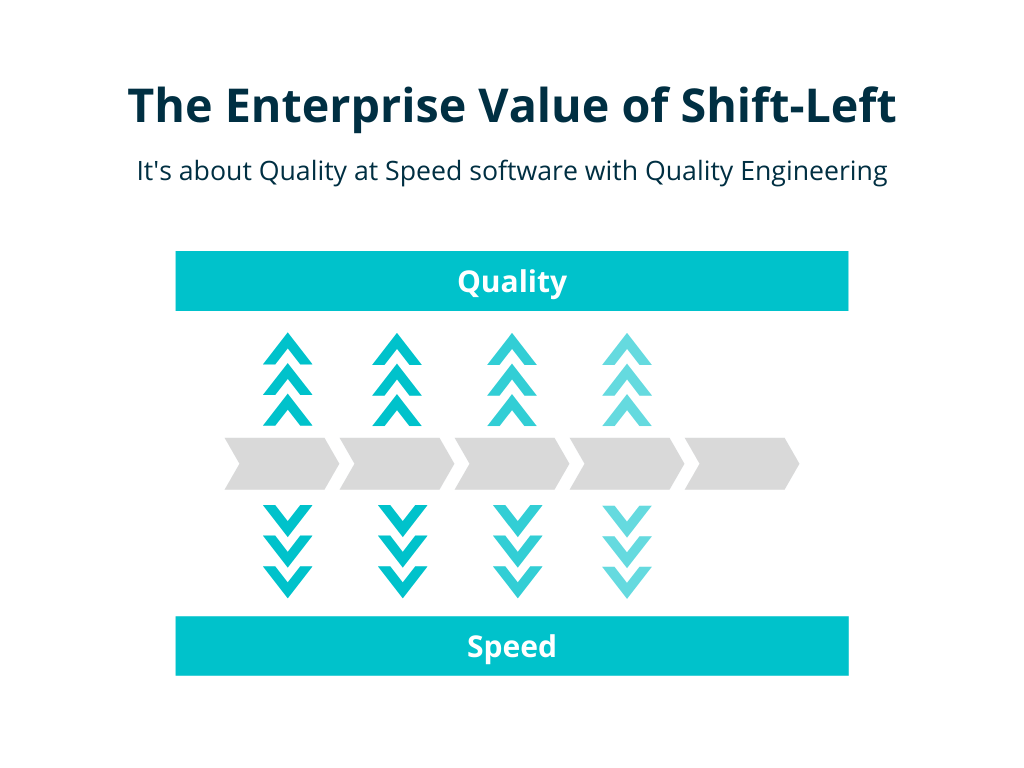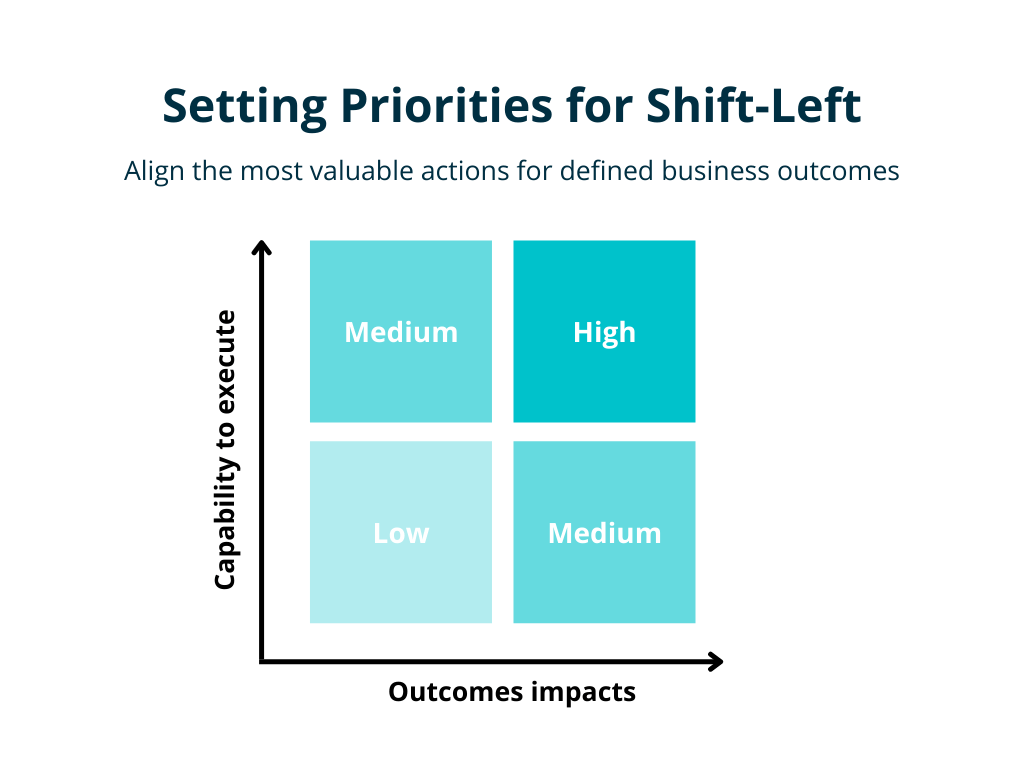How enterprises can shift left?
Antoine Craske
Posted On: June 17, 2022
![]() 15231 Views
15231 Views
![]() 7 Min Read
7 Min Read
Organizations are facing an increasing competition from digital actors with a capability of continuous adaptation through software. Their competitive advantage is to master the entire steps of the software lifecycle to continuously deliver Quality at Speed software.
But traditional approaches to quality slow down software delivery for most organizations; and focusing solely on speed in the short-term results in an ever-increasing technical debt thereby slowing down the rhythm of innovation, putting the organization’s viability in question.
That pressure makes companies look for solutions to improve the way they deliver software. An instinctive approach is to try improving the coding stage. But once companies understand that quality issues have underlying causes upstream in the software lifecycle, they look to act earlier.
Companies can leverage the paradigm of Shift-left to effectively balance quality and speed. The concept emerged in the software industry in Agile, DevOps, and Testing—but it’s the entire enterprise that needs to shift-left to succeed in the digital transformation.
First things first, understand Shift-left
The philosophy of shift-left is to improve the outputs of the software production process by performing upstream activities that help to detect issues earlier, reducing the cost of fixing them by a factor of 10 to 100. In reality, there is even more value in shift-left than cost reductions.
“Shift-left is about accelerating the delivery of valuable software.”
—Antoine Craske
The early involvement of actors contributing along the software lifecycle enables them to include by design requirements that avoid costly reworks once software has already been produced. That’s where shift-left is more than testing upstream: upstream quality contributes to more speed.
Companies capture additional value with shift-left by improving the collaboration of the teams with shared methodologies, constraints, and reviews. The upstream involvement fosters an environment where software is improved even when ideas are still on paper, supporting faster cycles.

Shifting-left is, therefore, a must-have for companies searching to accelerate their digital transformation. It enables faster iterations of software delivery that are improved earlier, tested faster, and delivered with a continuous velocity, contributing to organizational agility.
Introducing Test At Scale — a test intelligence and observability platform that shortens the testing durations & provides faster feedback. It enables devs to get early insights into flaky tests and enhances their productivity to ship code frequently with confidence. Start FREE Testing
Start with Why, defining the outcomes
The initiation of a shift-left dynamic usually leaves the team full of energy to implement practices they have heard about, such as Behavior Driven Development (BDD), starting to measure how many scenarios they cover. It must start the other way by defining the expected outcomes.
Enterprises aiming to embrace a shift-left dynamic must be able to articulate its contribution to the company strategy and business objectives. Even if shift-left activities can actually be measured locally, their bottom-line impact is to contribute to the business outcomes.
But there are difficulties for organizations to measure the outcomes of a shift-left initiative. Delayed feedback loops create a time gap between the implementation of practices and the measurement of results; thereby complicating the correlation between shift-left outputs with business outcomes.
That’s why organizations must measure shift-left performance in three main categories:
- Key business outcomes (i.e. KPIs) like customer satisfaction or new revenue streams
- Software lifecycle performance on quality and speed (e.g. Accelerate)
- Shift-left practices concrete actions through metrics.
These outcomes will drive the formulation of the enterprise shift-left vision.
Share the vision to align the organization
Organizational alignment is critical for creating a shared understanding about the need for change, what are the expectations, and what is likely to change for the teams. The burning questions to answer for everyone are “What’s in it for me” and “What’s next?”.
That stage is about creating content about the shared vision that can be presented in town-hall, team meeting and other instances. The key motivations defined in the previous must be present and easily remembered, easing the adoption and recall among teams.
One must-have message is about creating a quality engineering culture, where all actors collaborate along the lifecycle with the quality and speed imperatives in mind. Like in Toyota factories, anyone not satisfied with the outputs at one stage must be able to block the flow to improve it directly.
The start of the initiative is then about managing a series of incremental organizational transitions, starting small while keeping the entire enterprise up-to-date. The first transition requires leveraging your guiding coalition and identifying your “early wins shift-left team”.
Prioritize Shift-left activities and measurement
The first team to start with shift-left practices must be composed with a high probability of succeeding, picking your best assets with the necessary skills, open to new ideas and enable to drive the implementation of shift-left practices in short cycles.
The objectives and context must be first assessed to define the most valuable priorities that will contribute to key outcomes of quality and speed. The practices to implement must either contribute to improve the products upstream or reduce the risks of introducing defects along the software lifecycle.

The team has to analyze its software lifecycle performance according to the outcomes defined in the first step. For example, if the objective is to increase customer activation by 5%, deliver daily instead of every week, the team needs to define which shift-left practices make more sense.
Identifying the shift-left activities that could provide more value can be done with questioning:
- What actions that, if improved or added, would contribute to the outcomes?
- Where are the limiting factors in our current software lifecycle?
- At which stage non-functional requirements are best tackled?
- Which activities are generating the most rework? Why?
- Which steps are most likely to introduce defects?
The team can then identify which practices and measurements are more useful. If teams have too many reworks from the testing stage, they can invest in BDD in their user stories to perform them earlier with test automation. If there are security concerns, architecture reviews can be set up.
It is essential to systematically drill-down into the root causes of the identified symptoms to prioritize the correct shift-left actions. Teams can introduce defects due to a missing stable test environment, and not because of the quality of the specifications. That’s why measurement is needed.
Expand linking shift-left outputs to the outcomes
Shift-left for Enterprises should deliver successful incremental transitions to unlock its full potential across the organizations. Measurement is useful to follow the implementation progress but also to define when the switch to a new transition is required.
Once the first team has delivered valuable changes with shift left practices, it is then time to expand them among teams. It is critical at that stage to ensure the scalability of your foundations in terms of methodology, architecture, organization, management and skills.
Start by ensuring a properly-defined set of shift-left guidelines and practices that can be replicated by other teams using ambassadors from the early wins team. Similarly, ease the adoption with reusable templates, technology assets, and training materials.
The continuous measurement across your three categories will help you link shift-left outputs to the outcomes, ensuring that the expansion of the practices is effectively contributing to your enterprise objectives. That’s indeed why you started the initiative in the first place.
Shift-left for Enterprises, a necessary transformation
We saw that shift-left starts by clarifying the Why in the expected business contribution. That focus is what enables the implementation of the most valuable shift-left practices along their software lifecycle, depending on their context and priorities.
Enterprises able to shift-left can accelerate the delivery of quality (at speed) software, enabling them to sustain the necessary rhythm of the digital transformation. That velocity sustains the capability of the organization to remain valuable in our challenging ecosystem.
Shifting-left is a business imperative supported by, and not driven by technology. Only organizations that formulate a compelling shift-left vision can drive the necessary transitions to deliver sustainable changes for quality at speed software.
And, it all starts with the right leadership and vision
Got Questions? Drop them on LambdaTest Community. Visit now














